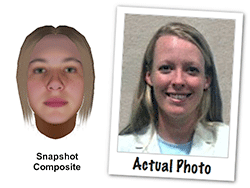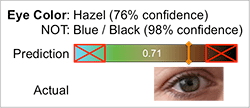March 2015
David J. Roberts, Senior Program Manager, IACP Technology Center
The use of Deoxyribonucleic acid, better known as DNA, recently crossed a new threshold in suspect and victim identification. Its use as a crime-fighting tool is likely to increase exponentially by providing detectives with a ready-to-post composite image, fit for a wanted or missing poster. The DNA within each human cell carries a genetic description of its host; by unlocking this genetic code, evidentiary DNA can provide a paint-by-numbers rendering that bears a striking resemblance to its source.
Developed over the past four years, this DNA decoding technology, known as DNA phenotyping, has been partially funded by the U.S. Department of Defense (DOD). In addition to aiding its own forensic investigations, the DOD recognized that the technology could help with identification of unknown remains, which is paramount in accounting for personnel missing in action (MIA) or prisoners of war (POW).
The Fall and Rise of DNA Analysis
Television crime dramas have falsely led the public to believe that DNA analysis is as accessible to police as a telephone or photocopier. As officers know, reality falls far short of this public misconception. Paradoxically, DNA's utility and popularity within the law enforcement community has led to a decline in its use as an investigative tool. Underfunded and understaffed crime labs struggle to keep pace with the demand for DNA testing. The ever-lengthening queues of unprocessed DNA evidence often result in lengthy turnaround times. As a result, police departments now increasingly relegate DNA analysis to the tail end of most investigations, authorizing it on a "must do" basis only.
Jason Chute, DNA Technical Leader at the Marshall University Forensic Science Center, explains: "Today, DNA testing is typically performed when a suspect has been identified, and a case is about to go to court. DNA is not nearly the investigative tool that it could be."1
While especially useful for John and Jane Doe identifications and unsolved cases, DNA phenotyping has the potential to help DNA analysis become an investigation priority. "A good DNA sample contains a wealth of investigative information, much more than has previously been utilized in criminal investigations," explains Parabon NanoLabs CEO Steve Armentrout, whose company has developed a DNA phenotyping service called Snapshot. "This extra information has the potential to help investigators exclude the not guilty with high confidence and begin building an accurate composite of a DNA source." He adds, "[Phenotyping] could move DNA analysis to the front of the investigation process because the efficiency gains from having this type of information at the outset are game-changing."2
DNA phenotyping is the science of predicting the ancestry or appearance of a person by decoding their DNA. With the use of complex software algorithms that mine data from thousands of reference samples, the genetic information in DNA is associated with physical traits. This knowledge can then be codified in computer software and used to make accurate predictions of physical appearance from new, unknown DNA samples.
How a Snapshot Composite is Derived from DNA
As high school science teaches, one of the easiest things to determine from a DNA sample is the sex of an individual. If both X and Y chromosomes are present, the source is male; if both chromosomes are X, then the source is female. Genetics research has also shown that many other phenotypes (i.e., traits) can also be reliably determined.
Since DNA maps people's physical destinies, telling their bodies how to grow and develop, it determines, along with environmental factors such as nutrition, one's physical appearance. DNA encodes the design of a person's physical characteristics in a genetic blueprint.
In addition to physical appearance, researchers can also use such blueprints to identify distant familial relationships between two DNA samples, such as second or third cousins, which is significantly more powerful than traditional DNA profiling based on short tandem repeat (STR) analysis. Genetic ancestry, which can be thought of as extremely distant kinship, allows for a prediction of a subject's race or ethnicity.
Dr. Ellen McRae Greytak, Director of Bioinformatics at Parabon, provides the following example: "Based on Snapshot analysis of a particular unknown test subject's genotype data, we were able to determine the origin of the subject's ancestors, that is, the proportion of biogeographic ancestry that can be attributed to each continent. This particular subject was found to be 54 percent East Asian, 39 percent Native American, and 7 percent European. From there, we performed detailed regional ancestry and mitochondrial DNA analysis, which established that the individual had a Japanese father and a Latino mother. These conclusions were confirmed as correct by the testing agency."3
Determining ancestry is just a starting point for producing a physical composite for use by criminal investigators. Just as scientists have been able to determine sex and ancestry from reading the genetic ladder of life, they can also accurately determine hair and eye color, facial shape, skin tone, and many other distinguishing features, including more unique traits such as freckling, and, soon, hair texture.
Does It Work?
While plausible in theory, the real question is whether DNA phenotyping actually works. Early versions of Snapshot have undergone and passed several blinded validation studies with major metropolitan police departments and federal agencies.
For traits such as skin, eye, and hair color, the predictions are typically reported at greater than 80 percent confidence. At first glance, especially for a forensic community accustomed to DNA identity tests with 99.99 percent accuracy, lower levels of confidence may seem impractical. Parabon researchers, however, have cleverly figured out how to stand the problem on its head with an innovation that highlights what may be the greatest forensic potential for DNA phenotyping—excluding phenotypes.
 
|
Tell Me Who It's Not
When investigators first reviewed beta versions of Snapshot reports, they noted that trait predictions of modest confidence would be of little practical value. The researchers soon realized, however, that phenotyping could also reliably rule out a subject.
Using eye color as an example, a prediction of "hazel" often has less than desirable confidence, simply because the observable differences between green, hazel, and light brown eyes are subtle. The possibility that an unknown subject receives a trait prediction of "hazel" when he or she actually has green or light brown eyes is sufficiently high to dampen confidence in the prediction. Instead, phenotyping can be more useful in determining what characteristics are extremely unlikely, i.e., the excluded phenotypes. For instance, a prediction of hazel eyes might come with an associated prediction of "not blue and not black at 98 percent confidence."
Distant Kinship Inference
One of the less-publicized capabilities of the technology could ultimately prove to be as forensically useful as phenotyping: determining kinship between any two DNA sources. This type of analysis could be indispensible for identification of unknown remains. According to Dr. Greytak, her team's kinship algorithm determined parent-offspring, full siblings, and second-degree relatives with 100 percent accuracy on a validation test of samples representing 1,282 known relationships, and distinguished sixth-degree relatives (second cousins once-removed) from unrelated pairs with 97.5 percent accuracy. Conventional DNA analysis does not have access to this content and is thus limited to parent-offspring determinations.
While still a relatively new technology, DNA phenotyping has the potential to become a useful investigative tool when DNA evidence exists. It can narrow the suspect list or help generate leads in cases where database searches return negative results. It's already proven useful for Police Chief Skip Holbrook of Columbia, South Carolina, who recently released what is believed to be the first published composite image in forensic history to be derived with DNA phenotyping. Detective Mark Vinson, who is investigating the four-year-old unsolved double homicide for which the image was developed, said, "We're very hopeful this composite could be the thing that prompts someone to come forward."4 ♦
Notes:
1Jason Chute (DNA Technical Leader, Marshall University Forensic Science Center), email, January 23,
2015.
2Steve Armentrout (CEO, Parabon NanoLabs), email, February 2, 2015.
3Ellen McRae Greytak (Director of Bioinformatics, Parabon NanoLabs), email, February 2, 2015.
4Cristina Corbin, "New DNA Technique May Reveal Face of Killer in Unsolved Double-Murder," FOX
News, Crime & Courts, January 19, 2015, http://www.foxnews.com/us/2015/01/19/new-dna-technique-could-put-face-on-unsolved-double-murder (accessed February 19, 2015).
Please cite as:
David J. Roberts, "A Kodak Moment for Law Enforcement: Using DNA Blueprints to Build Facial Composites," Technology Talk, The Police Chief 82 (March 2015): 78–79.
About Parabon NanoLabs, Inc.
Parabon NanoLabs is a vertically integrated DNA technology company that develops next-generation forensic and therapeutic products, which leverage the enormous power of DNA. Staffed by a uniquely qualified team of scientists and technologists, with expertise ranging from bioinformatics and chemistry to computer science and pharmacology, Parabon is bringing to market revolutionary new products and services made possible by recent advances in DNA sequencing, analysis and manufacturing technologies.
More information can be found at http://Parabon-Nanolabs.com/Snapshot or by calling (703) 689-9689 x250.
Media Contacts
Parabon NanoLabs
Paula Armentrout
P: 703.689.9689 x250
media@parabon.com
PR Contact
Laura Burgess Marketing
P: 252.288.5805
laura@lauraburgess.com


